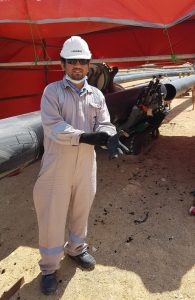The Arabian Desert is one of the most arid places in the world.
With an area of about 900,000 square miles (2,330,989 sq kilometers), this vast wilderness stretches from Yemen to the Persian Gulf and Oman to Jordan and Iraq, taking up most of the Arabian Peninsula.
Rainfall is a rare occurrence in the Arabian Desert.
Most areas only receive about 3.9 inches of rain annually, with some of the driest spots netting just 1.6 inches of rain per year.

In Oman, right in the middle of the Arabian Desert, an oil and gas exploration and production company was facing an additional challenge: the company was racing against an upcoming deadline to complete an HDPE pipe lining job. The solution was to contract with Plastic Pipes Welding, an official McElroy distributor in the Middle East. Plastic Pipes and Welding provides machine rentals along with machine operators, greatly reducing installation costs for their customers.


Plastic Pipes Welding sent a TracStar® 500, a TracStar® 900 and a machine operator who would also work as a team leader.
Aqib Shabbir arrived at the Mrmul Site in February, with the goal of fusing more than 15 kilometers of 28-inch (711mm) HDPE and 18 kilometers of 16-inch (406mm) HDPE. As part of the job, he and his team were expected to make at least 10 fusions on the 28-inch pipe and 15 fusions on the 16-inch pipe per day. On average, Aqib performed two welds per hour using McElroy equipment.
A Pakistan native, Shabbir first started working with plastic piping systems at just 14, when he was hired as a machine operator in an HDPE pipe factory. At 16, he traveled to Dubai, and since then he’s worked abroad to help provide for his family. He’s worked at Plastic Pipes Welding since 2018.
To make matters more difficult, some of the HDPE being fused was SDR 30, making it a very thin pipe.
In high temperatures like those found in the Arabian Desert, alignment becomes difficult – for example, PPW averages about three fusions per hour when working with standard ratios like SDR 11 or SDR 17.

Aqib and his team erected a fusion tent to keep the pipe itself out of direct sunlight and help with some of the heat.
Still, he didn’t know his team would also encounter other obstacles: scorpions and hydrogen sulfide.
As in many desert regions, scorpions also call the jobsite home, Shabbir said, and they were seen daily in the working areas.
“The first day, I spent the entire day watching around me and checking there were no scorpions around me,” Shabbir said. “Surprisingly, we got be used to working around them after some days.”
More concerning was the hydrogen sulfide gas.
“When we arrived at the job field, a strong egg smell surprised us,” Shabbir said. “The petrol wells launch hydrogen sulfide into the atmosphere.”
While this gas is deemed safe at certain levels, prolonged or high exposure to hydrogen sulfide can cause several severe health problems, including dizziness, altered breathing, and drowsiness. If levels are high enough or exposure is long enough, it can also cause death. For this reason, the jobsite is equipped with alarms to monitor the level of the gas and warn workers if necessary.
Luckily, Shabbir said, concentration alarms never sounded, and the gas was never any worse than a foul-smelling nuisance. And when the team successfully completed the job in June, the fresh, egg-free air was a welcome relief. In all, they’d fused 607 28-inch joints and 918 16-inch joints.
As companies like PPW continue to provide experienced operators and reliable McElroy equipment, even the toughest challenges can be solved in the field. With HDPE use steadily growing in the Middle East, McElroy equipment will continue to lead the way in providing HDPE fusion equipment like the TracStar line to help get the job done right, every time.

